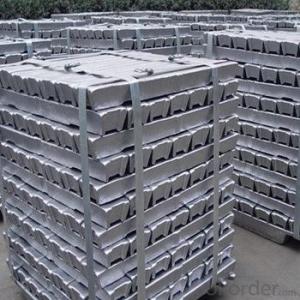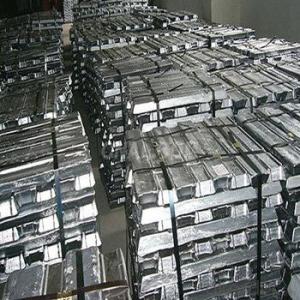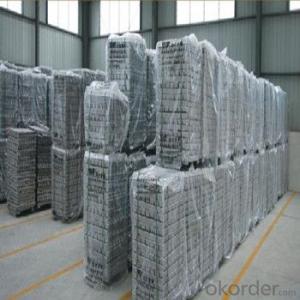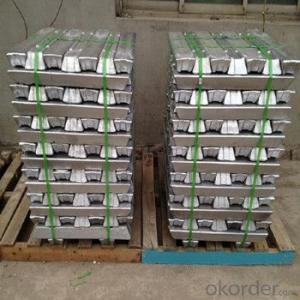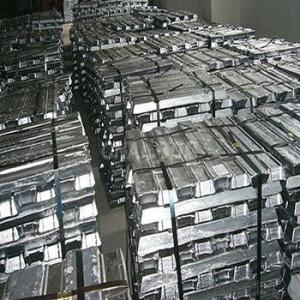Aluminium Ingots with High 99.99% Purity and Competitive Price
- Loading Port:
- China main port
- Payment Terms:
- TT OR LC
- Min Order Qty:
- 1000 m.t.
- Supply Capability:
- 10000 m.t./month
OKorder Service Pledge
OKorder Financial Service
You Might Also Like
Pure Aluminum Ingot Used for Industry
1.Structure of Aluminum Ingot Description
Aluminum Ingot is with the AL as the main chemical composition. Aluminum Ingot is used for industry,such as automobile,pinning and weaving,electron broadly and so on. Aluminum Ingot has the following advantages: easy control and operation, fast melting.
2.Main Features of the Aluminum Ingot
•High Purity
•Easy control and operation
•High strength
•Fast melting
•Competitive price
•Best Service
3. Aluminum Ingot Images

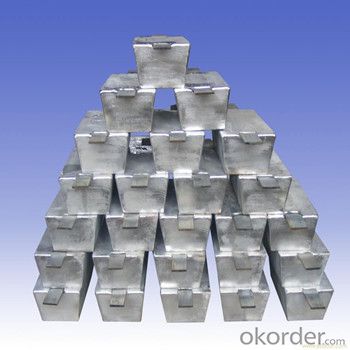
4. Aluminum Ingot Specification
Grade | Chemical Composition % | |||||||||
Al≥ | impurities ≤ | |||||||||
Si | Fe | Cu | Ga | Mg | Zn | Mn | others | Sum | ||
Al99.9 | 99.90 | 0.50 | 0.07 | 0.005 | 0.02 | 0.01 | 0.025 | - | 0.010 | 0.10 |
Al99.85 | 99.85 | 0.80 | 0.12 | 0.005 | 0.03 | 0.02 | 0.030 | - | 0.015 | 0.15 |
Al99.7 | 99.70 | 0.10 | 0.20 | 0.010 | 0.03 | 0.02 | 0.030 | - | 0.030 | 0.30 |
Al99.6 | 99.60 | 0.16 | 0.25 | 0.010 | 0.03 | 0.03 | 0.030 | - | 0.030 | 0.40 |
Al99.5 | 99.50 | 0.22 | 0.30 | 0.020 | 0.03 | 0.05 | 0.050 | - | 0.030 | 0.50 |
Al99.00 | 99.00 | 0.42 | 0.50 | 0.020 | 0.03 | 0.05 | 0.050 | - | 0.050 | 1.00 |
5.FAQ of Aluminum Ingot
We have organized several common questions for our clients,may help you sincerely:
①How about your company?
A world class manufacturer & supplier of castings forging in carbon steel and alloy steel,is one of the large-scale professional investment casting production bases in China,consisting of both casting foundry forging and machining factory. Annually more than 8000 tons Precision casting and forging parts are exported to markets in Europe,America and Japan. OEM casting and forging service available according to customer’s requirements.
②How to guarantee the quality of the products?
We have established the international advanced quality management system,every link from raw material to final product we have strict quality test;We resolutely put an end to unqualified products flowing into the market. At the same time, we will provide necessary follow-up service assurance.
③How long can we receive the product after purchase?
In the purchase of product within three working days, We will arrange the factory delivery as soon as possible. The pecific time of receiving is related to the state and position of customers.Commonly 7 to 10 working days can be served.
- Q:How are aluminum ingots used in the production of lighting fixtures?
- Aluminum ingots are used in the production of lighting fixtures as they serve as the primary material for constructing the fixtures' bodies and frames. The ingots are melted down and then cast into various shapes and sizes, allowing manufacturers to create durable and lightweight components for the fixtures. Additionally, the aluminum's excellent thermal conductivity helps dissipate heat efficiently, making it a suitable material for light fixtures that require effective heat management.
- Q:What are the safety precautions when handling aluminum ingots?
- To prevent accidents and ensure the well-being of those involved, it is crucial to adhere to specific safety measures when dealing with aluminum ingots. Consider the following precautions: 1. Personal Protective Equipment (PPE): Always wear appropriate PPE, such as safety glasses, gloves, and protective clothing, to safeguard against potential hazards like sharp edges, splinters, or metal contact. 2. Proper Lifting Techniques: Given the weight of aluminum ingots, it is vital to utilize correct lifting techniques to avoid strains or injuries. Bend at the knees and lift with your legs, maintaining a straight back. If the ingot is too heavy, seek assistance or employ mechanical aids like cranes or forklifts. 3. Secure Storage and Handling: Store aluminum ingots securely to prevent rolling or falling. Stack them in stable piles, using appropriate stacking equipment if necessary. Avoid storing them near flammable substances or in poorly ventilated areas. 4. Fire Safety: Aluminum can ignite when exposed to high temperatures or sparks. Therefore, keep ingots away from open flames, sparks, or potential ignition sources. Additionally, ensure the availability of fire extinguishers in case of emergencies. 5. Hazard Awareness: Be conscious of the potential hazards associated with aluminum ingots, such as sharp edges, friction burns, or the risk of metal fumes. Take necessary precautions to avoid these risks, including wearing suitable gloves, utilizing tools with safety guards, or working in well-ventilated areas. 6. Training and Education: Ensure that individuals handling aluminum ingots receive adequate training and education regarding safe handling practices. This encompasses understanding potential hazards, proper equipment usage, and familiarity with emergency procedures. 7. Regular Inspections: Regularly inspect aluminum ingots for any signs of damage, such as cracks or sharp edges. Remove any damaged ingots from use, as they increase the likelihood of accidents or injuries. By adhering to these safety precautions, individuals can reduce the risks associated with handling aluminum ingots and foster a safer work environment.
- Q:How much is the power consumption to smelt a ton of aluminium ingot?
- Plus you want to formula to aluminum alloy brand, higher temperature, and insulation process, estimated 700-800 degrees of electricity; processing into aluminum plate must be 1000 degrees electricity.
- Q:How much capital do I need to invest in the recycled aluminium ingot?
- This mainly depends on how much money you scale, there are local to not to do this, I am here in Foshan now, we're not here to make this move to distant places to engage in equipment, don't need how much, I have many friends in this, but now we're not here to do
- Q:How is aluminium powder made into aluminium ingot?
- If it is pure aluminum powder, then it needs smelting forming
- Q:Analysis of die casting aluminium ingot
- The commonly used classification, composition, die-casting aluminum ingot prices are as follows: the main element analysis table number grade classification (%) price (yuan / ton) Note: 9.6-12 1 ADC12 standard silicon, copper iron: 1.6,: 0.9,: 1,: 0.2 mg of zinc, lead as reference: 0.15
- Q:What are the advantages of using aluminum ingots in the production of automotive lightweighting solutions?
- There are several advantages of using aluminum ingots in the production of automotive lightweighting solutions. Firstly, aluminum is a lightweight material, which makes it ideal for reducing the overall weight of vehicles. By using aluminum ingots, manufacturers can significantly reduce the weight of various automotive components, such as body panels, engine parts, and structural elements. This reduction in weight leads to improved fuel efficiency, as lighter vehicles require less energy to accelerate and maintain speed. Additionally, it allows for better handling and maneuverability, enhancing the overall driving experience. Secondly, aluminum is a highly durable material that offers excellent strength-to-weight ratio. This means that even though it is lightweight, aluminum ingots provide sufficient strength and structural integrity to withstand the demands of everyday driving and ensure the safety of passengers. It can also resist corrosion, making it a suitable choice for automotive applications where exposure to harsh weather conditions or road salt is common. Another advantage of using aluminum ingots in automotive lightweighting is their versatility. Aluminum can be easily molded, shaped, and joined using various manufacturing techniques, allowing for the production of complex and intricate designs. This versatility allows manufacturers to create innovative automotive components that meet specific performance requirements without sacrificing weight reduction goals. Moreover, aluminum is a highly recyclable material, making it an environmentally friendly choice for automotive lightweighting solutions. The recycling process for aluminum consumes only a fraction of the energy required for primary production, resulting in fewer greenhouse gas emissions. This not only helps reduce the carbon footprint of the automotive industry but also promotes a more sustainable manufacturing process. Lastly, aluminum ingots offer cost advantages in the long run. While the initial production costs of aluminum components may be higher compared to traditional materials, such as steel, the overall lifecycle costs are often lower. The lightweight nature of aluminum reduces the demand on other vehicle systems, such as brakes and suspension, leading to potential savings in maintenance and replacement costs. Additionally, the recyclability of aluminum allows for the recovery and reuse of the material, reducing the need for new raw material extraction. In conclusion, the advantages of using aluminum ingots in the production of automotive lightweighting solutions include weight reduction, improved fuel efficiency, durability, versatility, environmental friendliness, and long-term cost savings. These benefits make aluminum a preferred choice for manufacturers aiming to enhance the performance, efficiency, and sustainability of modern vehicles.
- Q:What are the impurities found in aluminum ingots?
- The impurities commonly found in aluminum ingots include silicon, iron, copper, zinc, manganese, and magnesium.
- Q:What are the challenges in sourcing sustainable aluminum ingots?
- Sourcing sustainable aluminum ingots is not without its challenges. One of the main challenges is ensuring that the aluminum is produced in an environmentally-friendly manner. This involves minimizing the energy consumption and carbon emissions associated with the production process. Many aluminum smelters still rely on fossil fuels for energy, which can have a significant impact on the environment. Another challenge is verifying the origin of the aluminum. It is important to ensure that the raw materials used in the production of the ingots are ethically sourced and not linked to deforestation, human rights abuses, or conflict zones. This requires a robust and transparent supply chain that can trace the aluminum back to its source. In addition, there is a need to address the issue of waste and recycling. Aluminum is a highly recyclable material, but there are still significant amounts of aluminum waste that end up in landfills. Encouraging and incentivizing the recycling of aluminum is crucial to reducing the environmental impact of its production. Furthermore, the availability of sustainable aluminum ingots can be limited. Not all aluminum producers have adopted sustainable practices, and there may be a lack of supply in certain regions or industries. This can make it challenging for businesses to source sustainable aluminum ingots consistently. Overall, while there are challenges in sourcing sustainable aluminum ingots, it is essential to address these issues in order to promote a more environmentally-friendly and responsible aluminum industry. By working towards sustainable sourcing practices, we can reduce the environmental impact of aluminum production and contribute to a more sustainable future.
- Q:Can aluminum ingots be anodized?
- Aluminum ingots are capable of undergoing anodization. Anodization, an electrochemical procedure, yields a safeguarding oxide layer on the exterior of aluminum. This technique can be employed on aluminum ingots, sheets, or any other manifestations. Anodization boasts numerous advantages, including heightened resistance against corrosion, enhanced durability, and the potential to introduce color onto the surface. Moreover, the anodized layer enriches the aesthetic appeal of the aluminum and facilitates superior adhesion of paints or dyes. In summary, the anodization of aluminum ingots is a prevalent practice across diverse industries to augment both the properties and appearance of the metal.
1. Manufacturer Overview |
|
|---|---|
| Location | |
| Year Established | |
| Annual Output Value | |
| Main Markets | |
| Company Certifications | |
2. Manufacturer Certificates |
|
|---|---|
| a) Certification Name | |
| Range | |
| Reference | |
| Validity Period | |
3. Manufacturer Capability |
|
|---|---|
| a)Trade Capacity | |
| Nearest Port | |
| Export Percentage | |
| No.of Employees in Trade Department | |
| Language Spoken: | |
| b)Factory Information | |
| Factory Size: | |
| No. of Production Lines | |
| Contract Manufacturing | |
| Product Price Range | |
Send your message to us
Aluminium Ingots with High 99.99% Purity and Competitive Price
- Loading Port:
- China main port
- Payment Terms:
- TT OR LC
- Min Order Qty:
- 1000 m.t.
- Supply Capability:
- 10000 m.t./month
OKorder Service Pledge
OKorder Financial Service
Similar products
New products
Hot products
Related keywords







